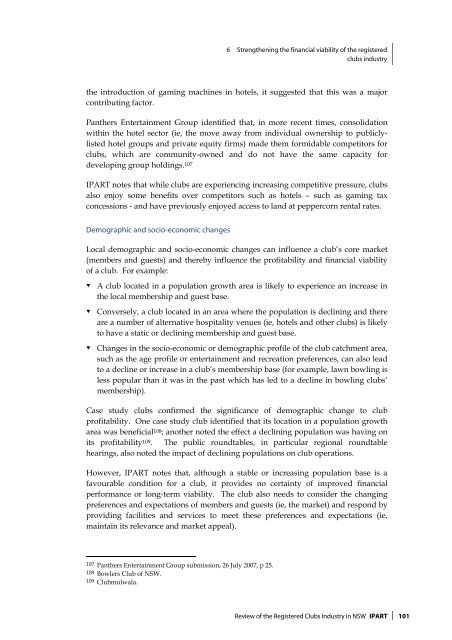Review of the Registered Clubs Industry in NSW - Clubs NSW
Review of the Registered Clubs Industry in NSW - Clubs NSW
Review of the Registered Clubs Industry in NSW - Clubs NSW
You also want an ePaper? Increase the reach of your titles
YUMPU automatically turns print PDFs into web optimized ePapers that Google loves.
6 Streng<strong>the</strong>n<strong>in</strong>g <strong>the</strong> f<strong>in</strong>ancial viability <strong>of</strong> <strong>the</strong> registered<br />
clubs <strong>in</strong>dustry<br />
<strong>the</strong> <strong>in</strong>troduction <strong>of</strong> gam<strong>in</strong>g mach<strong>in</strong>es <strong>in</strong> hotels, it suggested that this was a major<br />
contribut<strong>in</strong>g factor.<br />
Pan<strong>the</strong>rs Enterta<strong>in</strong>ment Group identified that, <strong>in</strong> more recent times, consolidation<br />
with<strong>in</strong> <strong>the</strong> hotel sector (ie, <strong>the</strong> move away from <strong>in</strong>dividual ownership to publiclylisted<br />
hotel groups and private equity firms) made <strong>the</strong>m formidable competitors for<br />
clubs, which are community-owned and do not have <strong>the</strong> same capacity for<br />
develop<strong>in</strong>g group hold<strong>in</strong>gs. 107<br />
IPART notes that while clubs are experienc<strong>in</strong>g <strong>in</strong>creas<strong>in</strong>g competitive pressure, clubs<br />
also enjoy some benefits over competitors such as hotels – such as gam<strong>in</strong>g tax<br />
concessions - and have previously enjoyed access to land at peppercorn rental rates.<br />
Demographic and socio-economic changes<br />
Local demographic and socio-economic changes can <strong>in</strong>fluence a club’s core market<br />
(members and guests) and <strong>the</strong>reby <strong>in</strong>fluence <strong>the</strong> pr<strong>of</strong>itability and f<strong>in</strong>ancial viability<br />
<strong>of</strong> a club. For example:<br />
<br />
<br />
<br />
A club located <strong>in</strong> a population growth area is likely to experience an <strong>in</strong>crease <strong>in</strong><br />
<strong>the</strong> local membership and guest base.<br />
Conversely, a club located <strong>in</strong> an area where <strong>the</strong> population is decl<strong>in</strong><strong>in</strong>g and <strong>the</strong>re<br />
are a number <strong>of</strong> alternative hospitality venues (ie, hotels and o<strong>the</strong>r clubs) is likely<br />
to have a static or decl<strong>in</strong><strong>in</strong>g membership and guest base.<br />
Changes <strong>in</strong> <strong>the</strong> socio-economic or demographic pr<strong>of</strong>ile <strong>of</strong> <strong>the</strong> club catchment area,<br />
such as <strong>the</strong> age pr<strong>of</strong>ile or enterta<strong>in</strong>ment and recreation preferences, can also lead<br />
to a decl<strong>in</strong>e or <strong>in</strong>crease <strong>in</strong> a club’s membership base (for example, lawn bowl<strong>in</strong>g is<br />
less popular than it was <strong>in</strong> <strong>the</strong> past which has led to a decl<strong>in</strong>e <strong>in</strong> bowl<strong>in</strong>g clubs’<br />
membership).<br />
Case study clubs confirmed <strong>the</strong> significance <strong>of</strong> demographic change to club<br />
pr<strong>of</strong>itability. One case study club identified that its location <strong>in</strong> a population growth<br />
area was beneficial 108 ; ano<strong>the</strong>r noted <strong>the</strong> effect a decl<strong>in</strong><strong>in</strong>g population was hav<strong>in</strong>g on<br />
its pr<strong>of</strong>itability 109 . The public roundtables, <strong>in</strong> particular regional roundtable<br />
hear<strong>in</strong>gs, also noted <strong>the</strong> impact <strong>of</strong> decl<strong>in</strong><strong>in</strong>g populations on club operations.<br />
However, IPART notes that, although a stable or <strong>in</strong>creas<strong>in</strong>g population base is a<br />
favourable condition for a club, it provides no certa<strong>in</strong>ty <strong>of</strong> improved f<strong>in</strong>ancial<br />
performance or long-term viability. The club also needs to consider <strong>the</strong> chang<strong>in</strong>g<br />
preferences and expectations <strong>of</strong> members and guests (ie, <strong>the</strong> market) and respond by<br />
provid<strong>in</strong>g facilities and services to meet <strong>the</strong>se preferences and expectations (ie,<br />
ma<strong>in</strong>ta<strong>in</strong> its relevance and market appeal).<br />
107 Pan<strong>the</strong>rs Enterta<strong>in</strong>ment Group submission, 26 July 2007, p 25.<br />
108 Bowlers Club <strong>of</strong> <strong>NSW</strong>.<br />
109 Clubmulwala.<br />
<strong>Review</strong> <strong>of</strong> <strong>the</strong> <strong>Registered</strong> <strong>Clubs</strong> <strong>Industry</strong> <strong>in</strong> <strong>NSW</strong> IPART 101
















